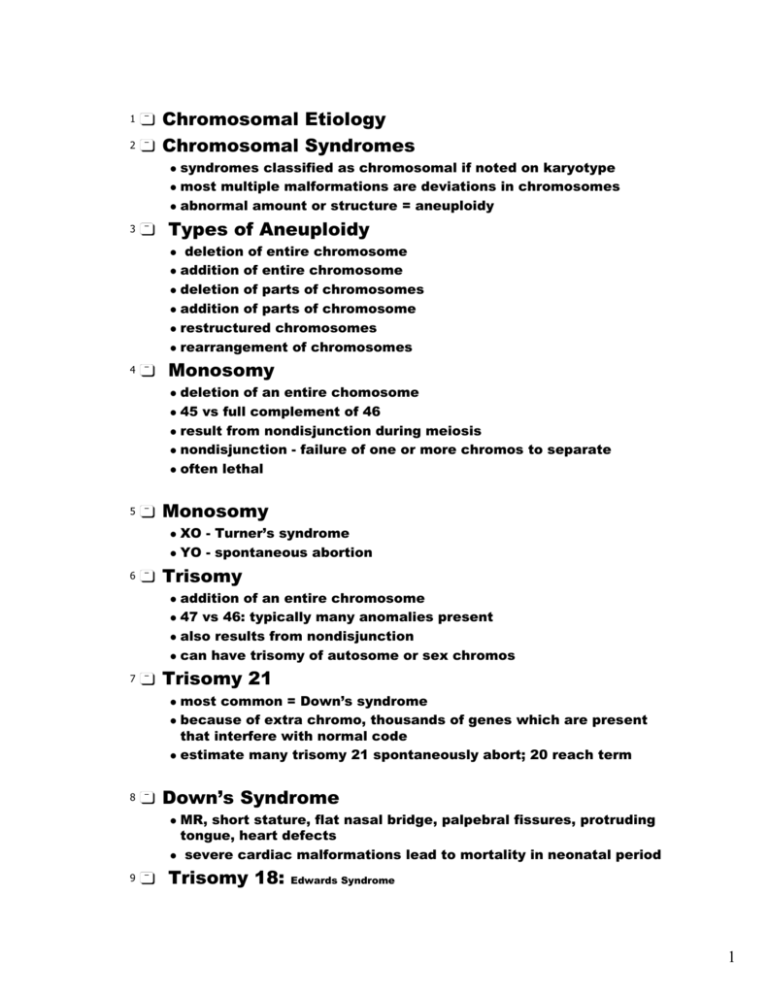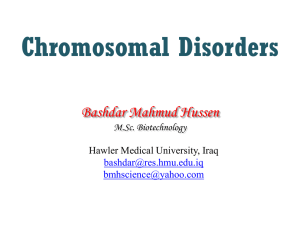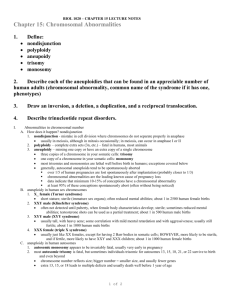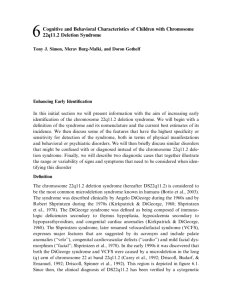Chromosomal Etiology Chromosomal Syndromes Types of
advertisement

1 2 Chromosomal Etiology Chromosomal Syndromes syndromes classified as chromosomal if noted on karyotype z most multiple malformations are deviations in chromosomes z abnormal amount or structure = aneuploidy z 3 Types of Aneuploidy deletion of entire chromosome addition of entire chromosome z deletion of parts of chromosomes z addition of parts of chromosome z restructured chromosomes z rearrangement of chromosomes z z 4 Monosomy deletion of an entire chomosome 45 vs full complement of 46 z result from nondisjunction during meiosis z nondisjunction - failure of one or more chromos to separate z often lethal z z 5 Monosomy XO - Turner’s syndrome z YO - spontaneous abortion z 6 Trisomy addition of an entire chromosome 47 vs 46: typically many anomalies present z also results from nondisjunction z can have trisomy of autosome or sex chromos z z 7 Trisomy 21 most common = Down’s syndrome z because of extra chromo, thousands of genes which are present that interfere with normal code z estimate many trisomy 21 spontaneously abort; 20 reach term z 8 Down’s Syndrome MR, short stature, flat nasal bridge, palpebral fissures, protruding tongue, heart defects z severe cardiac malformations lead to mortality in neonatal period z 9 Trisomy 18: Edwards Syndrome 1 z z z z z z 10 11 Prominent occiput/MR malformed ears flexed fingers rocker-bottom feet/prominent heel microagnathia limited life expectancy Trisomy 13-15: D Syndrome z MR, malformed ears, prepalatal cleft (65-75%), holoprosencephaly, z high mortality: 55% by 1st month, 66% by 6th Trisomy of Sex Chromos fairly common z often not detected at birth z XXX - MR; poss normal appearance: 1/4000 females z XXY - Klinefelter’s syndrome: small male gentalia, high voice, enlarged breasts, little body hair, MR: 1/1500 male z XYY - supermales over 6 feet: least impacted z 12 Deletion of Parts because only part missing, less severe consequences z two types of deletion z type based on position within the chromo z deletions occur at the ends of short (p) or long (q) arm = terminal deletions z when deletion in middle, interstitial deletion z 13 Deletion Syndrome 4p- ; Wolf-Hirschhorn syndrome z severe MR, growth deficiency, hypotonia, seizures, CLCP z cranial asymmetry, hypertelorism, strabismus, genital anomalies z many die in infancy z 14 Cri Du Chat: 5pz z z 15 cry like cat: small facial asymmetry, hypertelorism, epicanthal folds, downslanting eyes, low set ears IQ rarely exceeds 30 Contiguous Gene Syndromes variant of deletion: submicroscopic section is missing z V-C-F Syndrome: very small segment of the long arm of chromo 22 is delected z not usually detectable by karyotyping: requires molecular genetic procedures z 16 Mechanical Factors 2 developing fetus is normal; abnormality induced by factor extrinsic to fetus z facial clefts may result from impingement on developing embryo z account for only small percentage of all clefts z 17 Extrinsic factors z intrauterine crowding • twins • oliohydraminos: amall amount of amniotic fluid tears in amnion z presence of uterine tumor z abnormally small uterus z 18 19 20 Mechanical Deformation Sporadic/Unknown Etiology Two Types z recurrent pattern: genesis unknown • pattern that has been seen before but not attributable to any known factors: no family history, no chromosomal abnormality, no teratogeneisis z 21 provisonally unique: genesis unknown Recurrent Pattern: Genesis Unknown z Hemifacial microsomia: Goldenhar Syndrome • overwhelmingly number are sporadic • etiology remains unknown z Williams Syndrome • characteristic craniofacial pattern-thick lips, large mouth/no CL/CP • cognitively impaireed with sophisticated language system 22 Provisionally unique: genesis unknown kids with multiple anomalies/clefts that do not fit any pattern z scour literature; nothing like it z researchers anticipate seeing another: therefore “provisional” z 3









